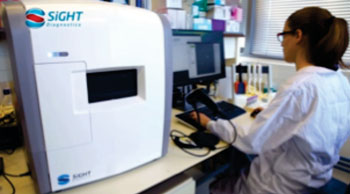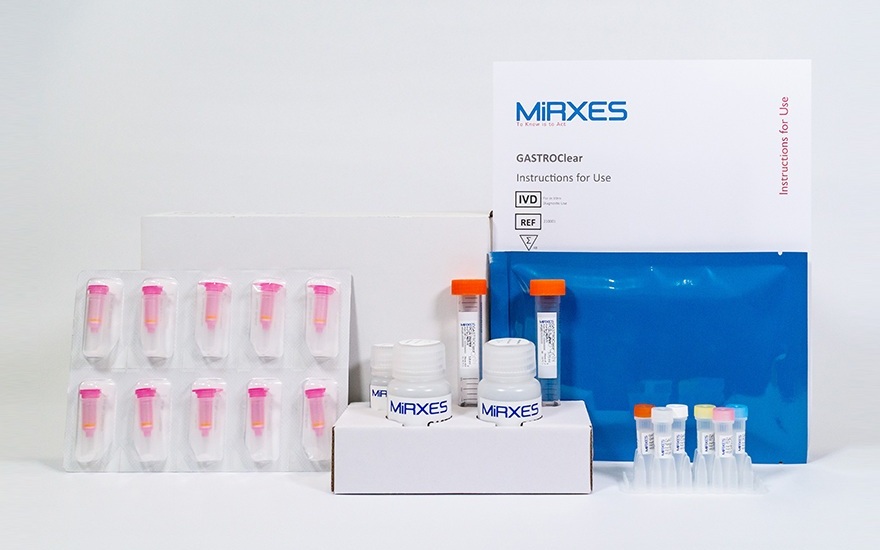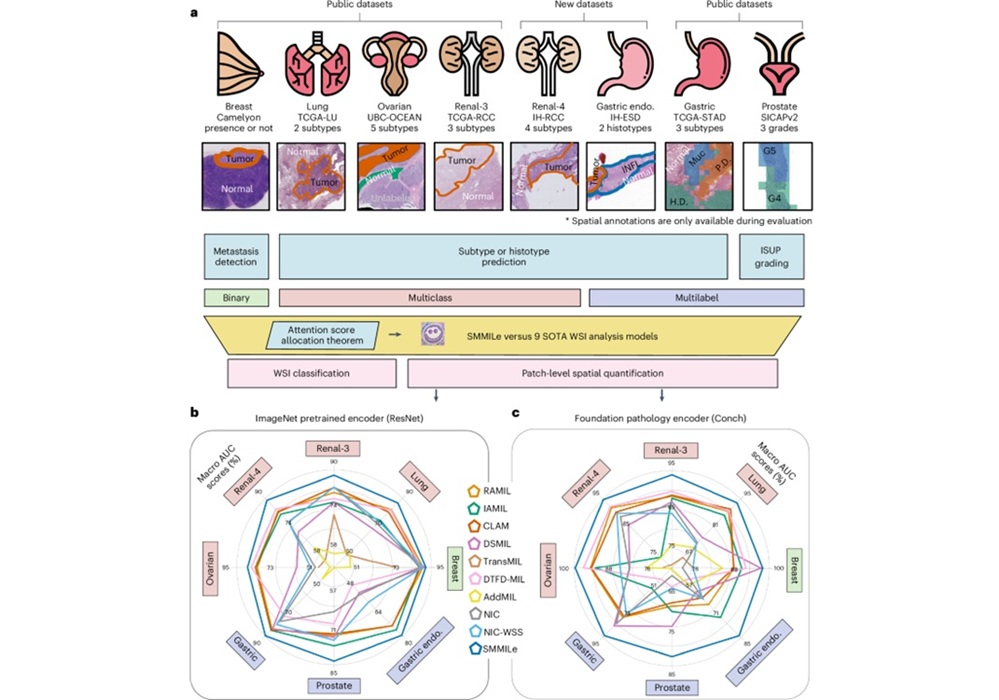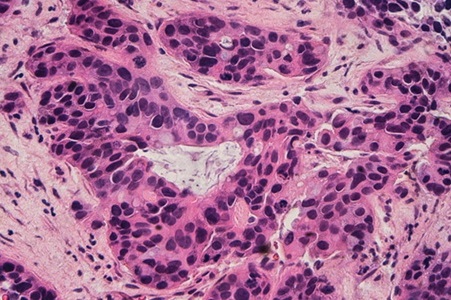Computer Algorithms Automatically Detect Malaria in Stained Blood Smears
|
By LabMedica International staff writers Posted on 10 Aug 2015 |

Image: The Parasight platform: computer vision technology scans stained blood samples under a fluorescent microscope and detects the presence of malaria parasites in blood cells (Photo courtesy of Sight Diagnostics).
An Israeli startup company has developed a computerized platform that detects anomalies in stained blood cell samples—such as those infected by the malaria parasite—faster and more accurately than the human eye.
Sight Diagnostics or SightDx (Jerusalem, Israel) was initiated in 2011 with six million USD obtained from crowd funding and several innovation investors. This funding was used by a team comprising biologists, software experts, and engineers to develop vision-based algorithms to scan and analyze blood. Analysis was based on visible characteristics such as size, shape, fluorescence intensity, and morphology.
The algorithms were set to function within SightDx's Parasight platform, a high throughput instrument suitable for batch (up to 30 samples) and asynchronous loading. It was designed to be fully automated, simple to operate, and optimized for rapid testing and analysis.
The Parasight platform consists of a scanning and analyzing device as well as a sample preparation kit containing custom-built disposable plastic cartridges to create an efficient, standardized, and uniform version of the “thin blood smear”, that is easy to prepare within 15 seconds. These cartridges require only a small drop of blood that can be obtained with a finger-stick or from a tube. Parasight reports, in under three minutes, the diagnosis (Positive/Negative), parasitemia count (number of parasites per microliter), and speciation (determination of the specific species of malaria). Results are automatically transferred to the laboratory information system.
Trials using Parasight were conducted in several hospitals in India, South Africa, and France. Results showed that it was 99% accurate in sensitivity and 98% in specificity as compared to results of about 95% for human microscopists.
“Essentially, you try to do what the human eye does,” said Joseph Joel Pollak, CEO of Sight Diagnostics. “Computer vision-based devices have a camera, and the camera takes pictures of the blood. Then, algorithms analyze the scene.”
Related Links:
Sight Diagnostics
Sight Diagnostics or SightDx (Jerusalem, Israel) was initiated in 2011 with six million USD obtained from crowd funding and several innovation investors. This funding was used by a team comprising biologists, software experts, and engineers to develop vision-based algorithms to scan and analyze blood. Analysis was based on visible characteristics such as size, shape, fluorescence intensity, and morphology.
The algorithms were set to function within SightDx's Parasight platform, a high throughput instrument suitable for batch (up to 30 samples) and asynchronous loading. It was designed to be fully automated, simple to operate, and optimized for rapid testing and analysis.
The Parasight platform consists of a scanning and analyzing device as well as a sample preparation kit containing custom-built disposable plastic cartridges to create an efficient, standardized, and uniform version of the “thin blood smear”, that is easy to prepare within 15 seconds. These cartridges require only a small drop of blood that can be obtained with a finger-stick or from a tube. Parasight reports, in under three minutes, the diagnosis (Positive/Negative), parasitemia count (number of parasites per microliter), and speciation (determination of the specific species of malaria). Results are automatically transferred to the laboratory information system.
Trials using Parasight were conducted in several hospitals in India, South Africa, and France. Results showed that it was 99% accurate in sensitivity and 98% in specificity as compared to results of about 95% for human microscopists.
“Essentially, you try to do what the human eye does,” said Joseph Joel Pollak, CEO of Sight Diagnostics. “Computer vision-based devices have a camera, and the camera takes pictures of the blood. Then, algorithms analyze the scene.”
Related Links:
Sight Diagnostics
Latest Microbiology News
- Rapid Assay Identifies Bloodstream Infection Pathogens Directly from Patient Samples
- Blood-Based Molecular Signatures to Enable Rapid EPTB Diagnosis
- 15-Minute Blood Test Diagnoses Life-Threatening Infections in Children
- High-Throughput Enteric Panels Detect Multiple GI Bacterial Infections from Single Stool Swab Sample
- Fast Noninvasive Bedside Test Uses Sugar Fingerprint to Detect Fungal Infections
- Rapid Sepsis Diagnostic Device to Enable Personalized Critical Care for ICU Patients
- Microfluidic Platform Assesses Neutrophil Function in Sepsis Patients
- New Diagnostic Method Confirms Sepsis Infections Earlier
- New Markers Could Predict Risk of Severe Chlamydia Infection
- Portable Spectroscopy Rapidly and Noninvasively Detects Bacterial Species in Vaginal Fluid
- CRISPR-Based Saliva Test Detects Tuberculosis Directly from Sputum
- Urine-Based Assay Diagnoses Common Lung Infection in Immunocompromised People
- Saliva Test Detects Implant-Related Microbial Risks
- New Platform Leverages AI and Quantum Computing to Predict Salmonella Antimicrobial Resistance
- Early Detection of Gut Microbiota Metabolite Linked to Atherosclerosis Could Revolutionize Diagnosis
- Viral Load Tests Can Help Predict Mpox Severity
Channels
Clinical Chemistry
view channel
Chemical Imaging Probe Could Track and Treat Prostate Cancer
Prostate cancer remains a leading cause of illness and death among men, with many patients eventually developing resistance to standard hormone-blocking therapies. These drugs often lose effectiveness... Read more
Mismatch Between Two Common Kidney Function Tests Indicates Serious Health Problems
Creatinine has long been the standard for measuring kidney filtration, while cystatin C — a protein produced by all human cells — has been recommended as a complementary marker because it is influenced... Read moreMolecular Diagnostics
view channel
Blood Protein Profiles Predict Mortality Risk for Earlier Medical Intervention
Elevated levels of specific proteins in the blood can signal increased risk of mortality, according to new evidence showing that five proteins involved in cancer, inflammation, and cell regulation strongly... Read more
First Of Its Kind Blood Test Detects Gastric Cancer in Asymptomatic Patients
Each year, over 1 million people worldwide are diagnosed with gastric (stomach) cancer, and over 800,000 people die of the disease. It is among the top 5 deadliest cancers worldwide for both men and women.... Read moreHematology
view channel
Platelet Activity Blood Test in Middle Age Could Identify Early Alzheimer’s Risk
Early detection of Alzheimer’s disease remains one of the biggest unmet needs in neurology, particularly because the biological changes underlying the disorder begin decades before memory symptoms appear.... Read more
Microvesicles Measurement Could Detect Vascular Injury in Sickle Cell Disease Patients
Assessing disease severity in sickle cell disease (SCD) remains challenging, especially when trying to predict hemolysis, vascular injury, and risk of complications such as vaso-occlusive crises.... Read more
ADLM’s New Coagulation Testing Guidance to Improve Care for Patients on Blood Thinners
Direct oral anticoagulants (DOACs) are one of the most common types of blood thinners. Patients take them to prevent a host of complications that could arise from blood clotting, including stroke, deep... Read moreImmunology
view channel
Gene Signature Test Predicts Response to Key Breast Cancer Treatment
DK4/6 inhibitors paired with hormone therapy have become a cornerstone treatment for advanced HR+/HER2– breast cancer, slowing tumor growth by blocking key proteins that drive cell division.... Read more
Chip Captures Cancer Cells from Blood to Help Select Right Breast Cancer Treatment
Ductal carcinoma in situ (DCIS) accounts for about a quarter of all breast cancer cases and generally carries a good prognosis. This non-invasive form of the disease may or may not become life-threatening.... Read morePathology
view channel
AI Tool Rapidly Analyzes Complex Cancer Images for Personalized Treatment
Complex digital biopsy images that typically take an expert pathologist up to 20 minutes to assess can now be analyzed in about one minute using a new artificial intelligence (AI) tool. The technology... Read more
Diagnostic Technology Performs Rapid Biofluid Analysis Using Single Droplet
Diagnosing disease typically requires milliliters of blood drawn at clinics, depending on needles, laboratory infrastructure, and trained personnel. This process is often painful, resource-intensive, and... Read moreTechnology
view channel
AI Saliva Sensor Enables Early Detection of Head and Neck Cancer
Early detection of head and neck cancer remains difficult because the disease produces few or no symptoms in its earliest stages, and lesions often lie deep within the head or neck, where biopsy or endoscopy... Read more
AI-Powered Biosensor Technology to Enable Breath Test for Lung Cancer Detection
Detecting lung cancer early remains one of the biggest challenges in oncology, largely because current tools are invasive, expensive, or unable to identify the disease in its earliest phases.... Read moreIndustry
view channel
Abbott Acquires Cancer-Screening Company Exact Sciences
Abbott (Abbott Park, IL, USA) has entered into a definitive agreement to acquire Exact Sciences (Madison, WI, USA), enabling it to enter and lead in fast-growing cancer diagnostics segments.... Read more








 (3) (1).png)















